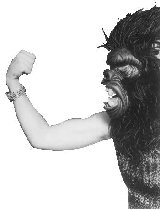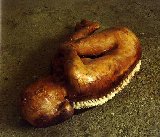5. The Body in Art and Philosophy
Possibly there is no topic more discussed in both feminist art and feminist philosophy today than “the body.” This interest represents continued exploration and critiques of traditional mind-body dualism, the role of sexual morphology in the development of gender and the self, and the venerable association of women with matter and physicality. Both the aesthetic and the theoretical modes of exploration of the body can be viewed as complementary elements of feminist aesthetics.
One route of inquiry along these lines concerns reevaluation of the senses and the orthodox materials that become objects of art. As we saw when considering philosophies of taste and the formation of the idea of the aesthetic, the literal sense of taste has never been considered a truly “aesthetic” sense, its pleasures and mode of apprehension being too bodily and sensuous to qualify. Vision and hearing are the aesthetic senses proper, according to traditional theory. This judgment is under question now, as the senses themselves are under reevaluation (Howes, 1991). Early speculation about the possible gendering of sense experience was ventured by theorists such as Luce Irigaray and Hélène Cixous, and a number of artists indirectly probe the issue by employing foodstuffs as the medium for their works (Korsmeyer, 2004, chs. 4-5).
The presence of actual food — as opposed to the depictions of still life painting — in art installations confounds traditional aesthetic ideals on a number of fronts. It challenges the idea that art has lasting value, because it literally decays. And while such art is to be viewed, it synaesthetically teases the senses of taste and smell as well. But it does so without the benefits that actually eating provides, for art made from food is not itself a meal. In fact, rather than pleasing to the sense of taste, this art frequently trades on the arousal of disgust in the sensuous imagination.

Janine Antoni, for example, has fashioned large sculptures from lard and from chocolate, employing her mouth, teeth, and tongue as the carving tools. Hardly appealing to the gustatory sense, this work nonetheless arouses a somatic response at the same time that it invites rumination on the venerable hierarchy of the senses that puts the distance senses of sight and hearing above the bodily senses of touch, smell, and taste. Czech-Canadian artist Jana Sterbak's Vanitas: Flesh Dress for an Albino Anorectic (1987) foregrounds the association of foods with female bodies. In this work, slabs of beef are stitched into a garment and arranged on a model for a period of display, during which the heavily salted beef dries and turns. Art such as this does not present food as elegantly edible but as prone to rot and decay, emphasizing the grossness of the substance. The uses of food on the part of female artists is particularly significant, given the traditional association of women with the body, with feeding and nurturance, and with transience and mortality. The very presence of large amounts of these creations in the artworld today has contributed to consternation on the part of professionals and public alike about just how art is to be defined and conceived. There is no particular feminist “definition” of art, but there are many uses to which feminists and postfeminists turn their creative efforts: exploring gender and sexuality as well as criticizing the traditions of art and of beauty imposed by aesthetic standards of the past.
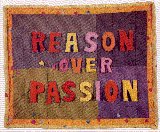
Critical consideration of norms of female beauty and the artistic depiction of women influences the ways that feminist artists employ their own bodies in creating art (Brand 2000; Steiner 2001). The work of artists across the globe utilizes bodies in different cultural and political contexts, dramatizing the recognition prevalent in contemporary feminist theory that there is no such thing as the female body, only bodies marked by the differences of their historical situation. The most dramatic uses of artists' bodies occurs with the relatively new genre of performance art, in which feminists have been pioneers. Of course, both men and women artists sometimes display their bodies in their art; with the female performer, however, there is a particularly deep invocation of conceptual tradition. As Susan McClary says, speaking of performance artist Laurie Anderson:
The fact that hers is a female body changes the dynamics of several of the oppositions she invokes in performance. For women's bodies in western culture have almost always been viewed as objects of display. Women have rarely been permitted agency in art, but instead have been restricted to enacting — upon and through their bodies — the theatrical, musical, cinematic, and dance scenarios constructed by male artists. Centuries of this traditional sexual division of cultural labor bear down on Anderson (or any woman performer) when she performs (McClary 1991, pp. 137-8).
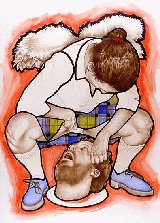
A good deal of performance art has been highly controversial, partly because of the exposure of the bodies of the artists in ways that not only challenge norms of female beauty but are deliberately gross or even borderline pornographic. The art tradition was long accustomed to pictures of nude females arranged in alluring poses. A performance artist who manipulates her body in ways that reverse the values of that tradition confronts the audience with a direct and emotionally difficult challenge to those values. Karen Finley, to mention a well-known case, calls attention to the sexual exploitation of women by smearing her body with foodstuffs resembling blood and excrement. This is an especially political use of disgust — an emotion that in earlier times was explicitly precluded from aesthetic arousal but that has become a major feature of the comprehension and appreciation of contemporary art.
Feminist explorations of embodiment and the deliberate arousal of disgust as an aesthetic response have at least two kinds of political and philosophical import. First of all, they invert feminine ideals that frame restrictive norms for personal appearance. This can be done humorously, boldly, sadly, aggressively, casually; much depends on the individual work. There are numerous ways to challenge the traditional aesthetic values expected in the female body, with a disturbing emotional effect that makes the audience question those values and their comprehensiveness. In addition, the arousal of disgust often occurs when artists move from consideration of the exterior of the body to its warm, dark, sticky interior where unmentionable substances are kept hidden away. The deliberate cultivation of that which is not pretty but is grossly material is the occasion for presenting some of the utterly taboo aspects of bodies: menstrual blood, excrement, internal organs. Female artists are not the only ones who explore interiority and materiality in art, of course. However, because of the venerable linkage of gross matter with the “feminine” (now the terrible feminine, not the highly socialized feminine of Burke's beauty principle), when female artists explore such themes they cannot but allude to venerable conceptual frameworks. This is a complex and delicate territory for feminist investigation: the ancient category of the feminine that includes the element of untamed nature and the gross matter of existence. Feminist uses of these types of objects play upon myths of nature and culture, of horror and sublimity, and of death and life. Rather than keeping these themes in the uncanny but clean realms of myth, however, the presentation of entrails, blood, and — sometimes literally — flesh confronts the audience with a particular and disturbing presence of the artist herself.
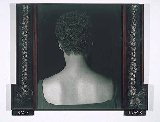
The suggestive ideas of French philosopher and psychoanalyst Luce Irigaray have provided inspiration for a number of feminist artists who seek to bring forth a “sexuate” perspective in their work that does not borrow from the patriarchal tradition, for the latter, according to Irigaray, has always eclipsed the expression of the “feminine” The body and its morphology are central to Irigaray's philosophical method, as she insists that sexuate being pervades one's existence, and that the pretense of shedding one's sex when writing or speaking in standard, familiar idioms and syntax causes the feminine to disappear into the masculine/neutral discourse that dominates the patriarchal order. As she puts it in the title of one of her widely-read essays, “any theory of the subject has always been appropriated by the masculine” (Irigaray 1985, p. 133). One of Irigaray's projects is to evoke feminine subjectivity that can be represented in its own terms, not just as an absence in the symbolic order. While the intricacies of her difficult philosophy are opaque and sometimes difficult to pin down, her suggestive ideas have furnished inspiration for feminists artists from painters (such as Nancy Spero) to performance artists (such as Joanna Frueh).
Art and aesthetic qualities are obviously not merely theoretical objects; they are cultural products with considerable authority to frame and to perpetuate social relations and values. Therefore feminist aesthetics contains a component where theories of interpretation are directed to particular works of culture. Feminist interpretive theories include approaches that are both competing and complementary, and they represent some of the same rivalries that are present in contemporary philosophy, broadly construed. Feminist interpretations are sometimes informed by Marxism and its varieties; and as we have already noted in the case of film and theories of the gaze, psychoanalytic theories have been widely appropriated in critical theory. Adaptations of psychoanalytic theory have an especially large presence in the interpretation of performance, literature, film and visual arts. Some feminists employ the discourse of Jacques Lacan, whose concept of the symbolic order has been widely applied to understand the power of patriarchy embedded in cultural forms of every kind (Copjec 2002). The psychoanalytic adaptations of Julia Kristeva, who analyzes the artistic experience of “abjection” as a threat to self arising from both the allure and the horror of self-disintegration and reabsorption into the body of the mother, is especially suggestive for understanding the aesthetic arousal of disgust and the strong sexual and gendered elements of horror (Kristeva 1982; Creed 1993).



